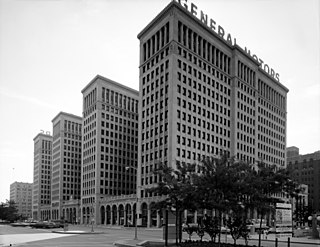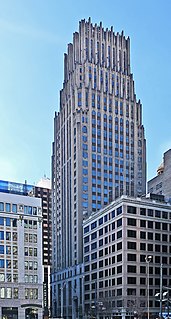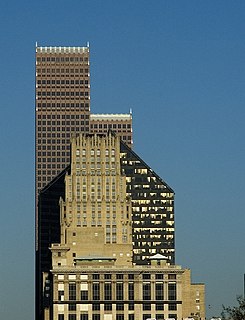
Baylor College of Medicine (BCM) is a private, independent health sciences university in Houston, Texas within the Texas Medical Center, the world's largest medical center. BCM is composed of four academic components: the School of Medicine, the Graduate School of Biomedical Sciences; the School of Health Professions, and the National School of Tropical Medicine.

The University of Texas MD Anderson Cancer Center is a comprehensive cancer center in Houston, Texas. It is the largest cancer center in the U.S. and one of the original three comprehensive cancer centers in the country. It is both a degree-granting academic institution and a cancer treatment and research center located at the Texas Medical Center in Houston. It is affiliated with The University of Texas Health Science Center at Houston.

The Prudential Tower, also known as the Prudential Building or, colloquially, The Pru, is an International Style skyscraper in Boston, Massachusetts. The building, a part of the Prudential Center complex, currently stands as the 2nd-tallest building in Boston, behind 200 Clarendon Street, formerly the John Hancock Tower. The Prudential Tower was designed by Charles Luckman and Associates for Prudential Insurance. Completed in 1964, the building is 749 feet (228 m) tall, with 52 floors, and is tied with others as the 114th-tallest in the United States. It contains 1.2 million sq ft (110,000 m2) of commercial and retail space. Including its radio mast, the tower stands as the tallest building in Boston, rising to 907 feet (276 m) in height.

The Metropolitan Life North Building, now known as Eleven Madison, is a 30-story art deco skyscraper in the Flatiron District adjacent to Madison Square Park in Manhattan, New York City, at 11-25 Madison Avenue. The building is bordered by East 24th Street, Madison Avenue, East 25th Street and Park Avenue South, and was formerly connected by a sky bridge and tunnel to the Metropolitan Life Insurance Company Tower just south of it.

Cadillac Place, formerly the General Motors Building, is a landmark high-rise office complex located at 3044 West Grand Boulevard in the New Center area of Detroit, Michigan. It was renamed for the French founder of Detroit, Antoine Laumet de La Mothe, sieur de Cadillac. It is a National Historic Landmark in Michigan, listed in 1985.

The JPMorgan Chase Building, formerly the Gulf Building, is a 37-story 130 m (430 ft) Art Deco skyscraper in downtown Houston, Texas. Completed in 1929, it remained the tallest building in Houston until 1963, when the Exxon Building surpassed it in height. The building is the Houston headquarters of JPMorgan Chase Bank, and was formerly the headquarters of Texas Commerce Bank.

Fourth Ward is one of the historic six wards of Houston, Texas, United States. The Fourth Ward is located inside the 610 Loop directly west of and adjacent to Downtown Houston. The Fourth Ward is the site of Freedmen's Town, which was a post-U.S. Civil War community of African-Americans.

The architecture of Houston includes a wide variety of award-winning and historic examples located in various areas of the city of Houston, Texas. From early in its history to current times, the city inspired innovative and challenging building design and construction, as it quickly grew into an internationally recognized commercial and industrial hub of Texas and the United States.

1001 Woodward is an office building in Downtown Detroit, Michigan. It replaced the Majestic Building, a 14-story high rise on the same site. The building is located just south of the neighboring David Stott Building, at the corner of Woodward Avenue and Michigan Avenue overlooking Campus Martius Park. Constructed from 1963 to 1965, the 25-story building is designed in the International Style. It was listed on the National Register of Historic Places in 2013.

John Fanz Staub was a residential architect who designed numerous traditionally-styled homes and mansions, mostly in Houston, Texas, from the 1920s to 1960s.

712 Fifth Avenue is a 650-foot-tall (200 m) skyscraper at 56th Street and Fifth Avenue in the Midtown Manhattan neighborhood of New York City. Constructed from 1987 to 1990, it was designed by SLCE Architects and Kohn Pedersen Fox Associates. The skyscraper's base includes the Coty Building at 714 Fifth Avenue and the Rizzoli Bookstore building at 712 Fifth Avenue, both of which are New York City designated landmarks.

Monroe Dunaway Anderson (1873–1939) was a banker and cotton trader from Jackson, Tennessee. With William L. Clayton, Anderson built Anderson, Clayton and Company into the world's biggest cotton company. In the event of one of their deaths, the partnership would lose a large amount of money to estate taxes and might be forced to dissolve. In order to avoid this, Anderson created the M.D. Anderson Foundation with an initial sum of $300,000. In 1939, after Anderson's death the foundation received an additional $19 million.
Karl Kamrath was an American architect and tennis player. He, along with Frederick James MacKie, Jr., created the Houston-based architectural firm Mackie and Kamrath. The firm's buildings reflected the principles of Organic Architecture and Usonian architecture, an outcome of Kamrath's friendship with Frank Lloyd Wright. His career spanned over five decades during which he designed residential, commercial, institutional and government buildings. Prior to founding MacKie and Kamrath, Karl Kamrath worked for Pereira and Pereira, the Interior Studios of Marshall Field and Company, and the Architectural Decorating Company in Chicago, Illinois.

Alfred Charles Finn was an American architect. He started in the profession with no formal training in 1904 as an apprentice for Sanguinet & Staats. He worked in their offices in Dallas, Fort Worth, and Houston. His credits during his tenure residential structures, but firm was a leader in steel-frame construction of skyscrapers.

ZGF Architects LLP (ZGF), formerly Zimmer Gunsul Frasca Partnership, is an American architectural firm with offices in Portland, Oregon; Seattle, Washington; Los Angeles, California; Washington D.C.; New York, New York; and Vancouver, Canada. Founded in 1942, the firm was listed in 2011 as the #4 architectural firm in the United States by Building Design+Construction, and ranked the #9 architectural firm by Architect. In 2016 Architect named ZGF the #1 architecture firm in the country, citing the organization's dedication to sustainability as a major deciding factor. Between the company's five offices in the United States and their office in Canada they employ more than 600 employees.

The Houston Main Building (HMB) formerly the Prudential Building, was a skyscraper in the Texas Medical Center, Houston, Texas. It originally housed offices of the Prudential Insurance Company, before becoming a part of the MD Anderson Cancer Center. The building was demolished on January 8, 2012. It was designed by Kenneth Franzheim.
Westbury Square was a shopping center located on a 7.5-acre (3.0 ha) site near the intersection of Chimney Rock Road and West Bellfort Avenue, in the Westbury neighborhood in the Brays Oaks district of Southwest Houston, Texas. It was built as a part of Westbury Section 3.

425 Park Avenue is an office building in New York City being redeveloped by L&L Holding and GreenOak Real Estate, with a design by architectural firm Foster + Partners. Work on the new structure began in 2016, and is expected to be completed in 2021.

945 Madison Avenue, also known as the Breuer Building, is a museum building in the Upper East Side of Manhattan, New York City. The Marcel Breuer-designed structure was built from 1964 to 1966 as the third home for the Whitney Museum of American Art. The Whitney moved out in 2014, after nearly 50 years in the building. In 2016, it was leased to the Metropolitan Museum of Art and became the Met Breuer, which closed in 2020. The building currently houses the Frick Madison, the temporary home of the Frick Collection set for a two-year period that began in March 2021. There are no public plans for the building after the Met's lease expires in 2023.

275 Madison Avenue is a 43-story office building in the Murray Hill neighborhood of Manhattan in New York City. It is along the southeast corner of Madison Avenue and 40th Street, near Grand Central Terminal. The building, constructed from 1930 to 1931, was designed by Kenneth Franzheim in a mixture of the Art Deco and International styles.


















